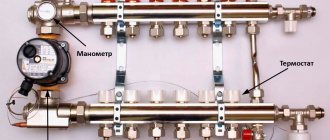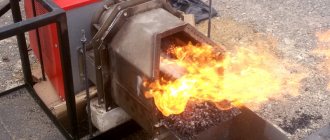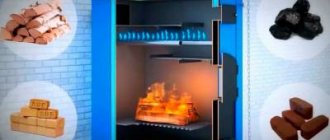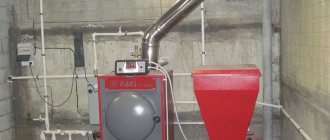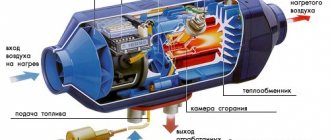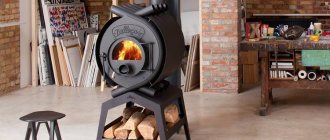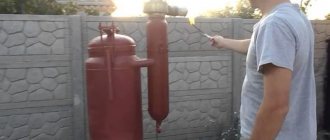The instability of the energy market forces us to look for alternative solutions and remember the democratic nature of coal dust. It is unprofitable to use it in its pure form: it falls through the grate bars or gets baked, clogging the firebox. Additives to firewood have a pronounced effect, but you need to sprinkle it often and little by little so as not to disrupt the circulation of gases. And only coal briquettes compressed from dust are easy to use and burn with high heat output.
Coal briquettes have a long burning property
Coal-wood briquettes: types of raw materials
The relatively low price, ease of manufacture, availability of purchase and efficiency of fuel briquettes have led to increasing popularity among consumers and their widespread distribution. Meanwhile, there are varieties of this type of fuel according to the raw materials used, as well as the shape of the final product.
Coal briquettes for heating are made from different types of coal, such as:
- brown (the most common and cheapest option);
- wood (more complex manufacturing technology, involving the use of additional equipment);
- anthracite (the most expensive, but also the most efficient raw material: the best heat transfer rates).
The production of briquetted fuel does not require high quality raw materials. Coal dust and fines are quite suitable for this purpose, as well as waste that does not sinter well, falls through the grate and is not suitable for direct use in furnaces or coke production.
Features of the briquetting process
Briquetting is the production of material fractions of different sizes, to which some binders are added. This structure is pressed into granules of a special shape. The direct process of creating briquettes is universal. Its technology is considered the most energy-efficient. Recycled and recycled metal fractions make it possible to reduce the cost of creating a charge. In addition, the widespread use of briquettes improves the quality of products and reduces their cost. The use of recycled materials in metallurgy is as relevant as the question of where to buy high-quality ceramic tiles.
Processing waste into briquettes and pellets is an effective method of reducing the consumption of iron ore raw materials by 10% when smelting one ton of industrial cast iron. Briquetting technology also takes into account gas and dust emissions that are generated during standard methods of preparing coke raw materials for smelting. In comparison with the complexity of these processes, ordering an interior design project seems elementary. When equipping the metallurgical complex zone with briquetting equipment, the profitability of producing briquettes can reach 200%.
Adhesives
Various components can be used as a binder, which affect the quality and characteristics of the final product. These are substances such as:
- coal tar;
- clay;
- soda;
- syrup;
- resin;
- dextrin;
- lime;
- protein and many others.
The choice of binding component directly depends on the type of main raw material and its quality. Also, depending on the use of a particular component, the technology for producing briquettes and its labor intensity will change.
Safety rules for coal preparation and briquetting
If you decide to use briquetted coal as fuel, you should approach its production with all responsibility. The components for the manufacture of solid fuel are selected depending on the place of its use. The composition of briquettes should not contain harmful components, so as not to be poisoned by the products of their combustion.
A low-quality product may have poor heat transfer and fail to cope with its direct responsibilities of heating the room. Poorly compressed briquettes will quickly turn into dust and go to waste.
What are they?
Coal briquette is a solid fuel product manufactured in the form of bars of various configurations and sizes, which are pressed under high pressure and temperature. Cementing components, which can be organic or inorganic, are used to hold together the particles of raw materials and strengthen the products.
The efficiency of this energy carrier lies in its heat transfer parameters and combustion duration, which are higher than those of conventional coal. The shape and density of the briquettes also play a role in efficiency because they allow the fuel to maintain an even, predictable burn and maintain a constant temperature throughout the combustion process. The waste remaining after attenuation in the form of ash is only 3%; for traditional coal this figure is 10 times higher, while the briquettes do not fall apart in the oven until they burn out completely.
Advantages and disadvantages of the product
Sellers of coal briquettes insist that the calorific value of their product is significantly higher than that of other types of fuel. This may be true, since the heat of combustion of 1 kg of anthracite is 8 kilowatts, and firewood and wood-based briquettes emit up to 5 kW/kg. The advantages of briquetted coal also include:
- enlargement of particles of the initial fraction;
- reducing the volume of harmful emissions into the atmosphere during combustion;
- high quality products with standard indicators;
- ease of storage and transportation;
- ease of spending control;
- combating spontaneous combustion of fine coal;
- environmental cleanliness and absence of harmful chemical additives;
- high heat transfer;
- ease of ignition and burning duration.
However, owners of solid fuel boilers cite a number of reasons for the low popularity of coal briquettes in comparison with their wood counterparts. The disadvantages include the following:
- the equipment is difficult to heat, and the fuel does not provide enough heat;
- when burning in the premises there are unpleasant odors;
- products crumble freely and become shapeless during transportation;
- A large amount of ash is formed.
Negative reviews are understandable if we remember that unscrupulous manufacturers, in order to obtain maximum profits, try to use charge, sludge and other coal products that are unsuitable for heating needs. Real anthracite briquettes with a rich black glossy color are difficult to find on sale. This leads to the logical conclusion that it is preferable to make coal briquettes yourself and purchase high-quality raw materials for this.
You should not waste effort and money on pressing low-calorie types of coal, although such briquettes, in proper combination with firewood, will significantly reduce overall costs during the heating season. Manufactured using a homemade method, they differ unfavorably from factory-made analogues: they produce little heat when burning, are fragile and are destroyed during transportation. But here it is possible to take care of the quality of the source material and adjust the content of additives. And the cost of homemade bricks, pillows and sausages turns out to be much more attractive than the prices of their factory-made counterparts.
Where to use and where not to use
It is mainly used for heating needs in everyday life, but recently it has become more often used in metallurgical and chemical plants, as well as power plants and boiler houses. In general, briquettes can be used in any enterprise or in a private home where equipment that runs on solid fuel is installed - coal, firewood, etc.
But you should know that under no circumstances should you use a charcoal briquette to start a fire in barbecues, grills and other ovens for cooking where there is direct contact of smoke with food. Such equipment is simply not designed for the temperature produced by this fuel, and it will fail, and the caustic and harmful substances contained in the coal released will make the food unfit for consumption.
Laying and pressing the resulting mass
Using a small bucket, the resulting mass is placed in all 4 compartments of the press, the jack with platforms is lowered down. It is necessary to understand that the compartments must be filled to capacity. After the press has completed its task, the briquettes will be only about 5 cm high.
By rotating the jack handle, the operator lowers the platforms all the way down. All squeezed water is drained through a gutter into a bucket - it will later be used again.
The jack is designed in such a way as to neutralize human efforts. However, there comes a time when even he is not able to push the platforms any further. Then you need to wait a couple of minutes until the remaining liquid drains, and you can take out the almost finished briquettes. Why "almost"? Yes, they just need to dry thoroughly. While they are raw, they can be broken by dropping them from a height. But when the briquettes dry out, it becomes difficult to break them even with a hammer.
Industrial production
Since the manufacturing technology differs somewhat depending on the type of binder, we can consider the production of coal briquettes based on the most commonly used component - coal tar (coal tar).
First, the raw materials are washed to remove impurities, and then crushed and dried to the required parameters. For this purpose, it is poured into the crusher through the receiving hopper, and then, through a screw, it enters the dryer. Dried coal fines are sorted into fractions: coals measuring from 0 to 6 cm go into the mixer, and larger ones go back into the crusher. After calibration, a binder is added to the mixer to the prepared base raw material.
When the necessary components are loaded, they are mixed into a homogeneous mass, which is distributed into the cells of the molds, where, through hot steam and high pressure, the resulting mixture is converted into a coal briquette. The resulting products are transferred to cooling bunkers for 8 hours. Screening out defective forms and subsequent packaging into 25 kg bags completes the production process.
Industrial process stages
The production of coal briquettes has a long history and has received new development with the advent of special presses. This increased labor productivity and made it possible to produce products with decent density and heat transfer properties while maintaining low costs.
In the factory, for the production of coal briquettes, a technological chain is used, consisting of a dryer, a crusher and a press, and the delivery of products is ensured by a conveyor belt.
Briquetting goes through many stages
Briquetting using binder additives is carried out in several stages:
- Drying of feedstock. A direct method using heated gas or an indirect method using warm steam is possible. The strength of the finished briquette depends on how much moisture the original components contained. The permissible humidity is about 15%.
- Extraction of volatile substances. Necessary for low quality coals contaminated with impurities. It is carried out in a distillation apparatus or coke oven.
- Sorting by factions. Fines with a particle size of up to 6 mm are sent to a special mixing hopper, and raw materials over 6 mm are sent to a crusher.
- Grinding of coarse fractions in a crusher to a particle size of less than 6 mm. The smaller the grain size, the stronger the briquette.
- Combination with binders by heating in a paddle mixer or clay mixer. Required to ensure sufficient strength of products during transportation and use. The mass fraction of additives ranges from 5 to 15%.
- Compaction by pressing in equipment of various designs. Depending on the characteristics of the installations, the working pressure reaches 150 MPa. The density of the mixture of coal and binder increases several times - from 1.5 to 3.
- Firing in a closed conveyor heated by high-temperature gases. To strengthen briquettes, a number of binders (ammonium lignosulfonates, petroleum bitumen) require additional heat treatment at 300°C.
- Cooling in a hopper with air circulation. Within 8 hours, the finished products reach ambient temperature, and the exhaust gases are collected, purified and released into the atmosphere. A cooling option is possible by extinguishing with specially prepared water.
- Packaging and transportation to storage warehouses.
Pressed bricks and cylinders successfully replace conditioned coals as fuel for metallurgical or chemical industries, as well as private boiler plants.
Equipment for the production of briquettes
The method of forming products depends on the equipment used. Two fundamentally different types of units are possible:
- Stamp press. Suitable for producing large quantities of briquettes due to energy intensity and financial cost. The heated coal mass is filled into molds and pressed under pressure from 100 to 120 MPa. The finished product is cooled and takes the form of bricks, tablets and pillows.
- Extrusion machine. It has lower costs and more modest productivity. The plastic coal mixture is fed by a screw into the matrix and pressed through it. Extruded briquettes have the shape of cylinders with a hole in the center.
The factors that determine particle size, humidity and pressure during briquetting are the intended use of the product and the features of the equipment. The quality of the feedstock affects the energy intensity of the process. Small anthracite fractions and dust lend themselves well to processing, while other types of coal behave worse.
To obtain such a briquette, several equipment is used
DIY coal briquettes
For these purposes, you can use a hand press or a homemade screw extruder. You can also, in the absence of equipment, do this manually. Unlike the factory manufacturing process, at home, instead of drying fine coal, it is mixed with water. No need to add binder. The main thing is to comply with two conditions:
- coal fraction - no more than 6 cm and the smaller the better;
- the resulting mass must be plastic and thick so that it can be sculpted by hand or briquetted in a mold using a hand press.
After the briquetting process, the products should be thoroughly dried. It should be noted that the coal briquette obtained by manual pressing is unsuitable for transportation, since it is more fragile than the factory one. Also, the manual method has very low productivity: it will take a lot of effort and time to prepare fuel for the whole season.
The use of an extruder speeds up the briquetting process, and the quality of the products is much higher than with the manual manufacturing method. Here you just need to pour raw materials into a bunker and get finished products of high quality that are suitable for transportation. However, the cost of the unit itself and its components (electric motor, gearbox, etc.) is high and not everyone can afford it.
Types of briquettes
Let's figure out what types of briquettes for heating exist and their components. There are several types of such briquettes:
- wood briquettes;
- peat briquettes;
- briquettes from hard coal.
Let's take a closer look at each type of fuel.
Wood briquettes
This type of briquettes is made from sawdust and other materials - waste from the wood processing industry. The raw materials are first heated and then pressed. To do this, use high pressure on the chips. Under pressure from the load, the wood releases lignin. It acts as glue. After it hardens, the mass does not lose its shape and is quite durable to the touch. Lignin is a natural material and does not cause any harm to the human body. Wood briquettes have some important characteristics. Fuel moisture content is 10%. As you can see, the moisture content of the finished material is several times lower than wood. At the moment of combustion, sawdust releases 4400 kcal/kg. If we compare this indicator and heating with sawdust with burning coal, we note that the indicator is 3910 kcal/kg.
Wood briquettes
The density of wood is not the same, it all depends on the original type of wood from which it was obtained. It is also important that when a wood heating briquette is burned, a small amount of ash remains. Its figure does not exceed 0.12%. While coal leaves behind 20% ash. Wood briquettes for heating are convenient because there is no crackling sound during combustion and they do not produce a spark. The formation of smoke is minimal and at the same time this type of fuel is capable of releasing heat into the room for several hours. A completely wood block burns out in 4 hours. If you do not remove the ash and coals, you can use them for cooking.
The most important thing about this type of fuel is that heating with sawdust with your own hands is safe in all respects for humans.
If you compare it with coal, when burned, wood produces several times less carbon monoxide than other materials. The form in which wood blocks are produced is convenient in practice. This allows you to not take up a lot of space for fuel storage. Euro firewood is suitable as fuel not only for solid fuel boilers. They can be used to start a fire outdoors and to light a fireplace. Also, firewood in the form of wood blocks is easy to control consumption.
Fuel briquettes can be used for cooking on the grill
You can calculate how many blocks you need to heat a certain area. Knowing this value, you can easily determine the volume of fuel purchased for the season. Remember, when buying solid wood, you pay not only for the material, but also for water and air. As you can see, heating with pressed sawdust is not only profitable from an economic point of view, but also safe in terms of health. You also have the opportunity not to cut down forests and other green spaces in order to heat your house with sawdust.
Peat briquettes
Peat briquettes are produced similarly to wood briquettes. The peat is initially dried and pressed. If peat is exposed to high temperatures, it begins to compact and turn into blocks. This form is convenient for storing and delivering cargo. Peat briquettes can be used to heat all types of stoves. This type of fuel is characterized by high thermal output over a long period of time. As you can see, peat briquettes for heating are another option for replacing solid wood for heating premises. If your boiler allows you to regulate the air supply, then the burning time of peat blocks increases to 8 hours.
Coal for heating
Peat briquettes
This fuel will be a good replacement for another fuel option for heating rooms at night. At this time of day, it is important for you to keep the air temperature in the room at a level comfortable for normal life. Let us remind you once again about the form. Peat briquettes for heating are small in shape for easy transportation and for heating the stove. In order for the boiler to constantly heat the water, it is enough to add new briquettes at regular intervals.
Ash after combustion of peat briquettes can be used as fertilizer for phosphorus feeding of plants on the site.
This fertilizer alternative will appeal to many gardeners. Let's figure out what is more profitable - firewood or pellets. To buy a ton of peat blocks, you have to pay approximately 6,000 rubles. A ton of firewood of any type of wood costs 2,000 rubles. Let's recalculate the heat transfer rates of these materials. It turns out that 2.4 kWh/kg comes from firewood and 5 kWh/kg comes from burning pellets. As you can see, it is much more profitable to purchase artificial fuel. Also, the practicality of peat briquettes lies in the fact that there is no need to chop firewood into convenient logs, dry them and allocate large areas for storage.
COAL BRIQUETTING WITHOUT BINDER
The binderless coal briquetting plant consists of the following components:
- coal sorting and grinding area if the coal size is too large
- drying area if the moisture content of the coal is too high
- briquetting area on a two-roller press
The capacity of a coal briquetting plant without binder can range from several tons per hour to approximately 25 t/h.
Features of heating with wood
SpdFORUMHOUSE user
I heat my house with a 30 kW solid fuel boiler. At first I tried throwing wood into the firebox. Did not like. They burn out in about 30 minutes, maximum in 1 hour. I didn’t get a small amount of coal for testing. I bought fuel briquettes made from sawdust. The full combustion chamber of a TT boiler is about 10 kg, burns for 1.5 hours from ignition to smoldering while maintaining a coolant temperature of at least + 60 °C. In the technical specifications for different boilers it is written that the operating time on one stack of firewood is from 4-8 to 12 hours. Is this real and how to achieve it? Share your experience!
According to chicken-A, in his solid fuel boiler, a full load of birch firewood (firebox volume 42 liters) burns for about 3-4 hours, and sometimes longer. The starper burns five logs for 3-4 hours. With spdim, firewood burns from 2 to 6 hours, but a lot depends on the boiler load (if you fill the firebox to the maximum - 20-22 kg), the type of fuel and its humidity.
spdimForumHouse User
I think the problem with Spd is due to wet wood, or due to the installation of softwood. I have a similar picture if you throw rotten aspen or poplar into the firebox. They burn out quickly, but you can’t get any heat from them. Good dry birch or oak wood burns as it should. Well, the house needs to be well insulated.
So, humidity and type of wood (low, medium and high density) directly affect the calorific value (specific heat of combustion), i.e. the amount of heat released during the combustion of fuel of a certain volume or mass.
For comparison:
- The specific heat of combustion of 1 kg of freshly cut wood with a humidity of about 50% is 1940 kcal or 2.2 kWh.
- The specific heat of combustion of 1 kg of dried wood with a humidity of about 20% is 3400 kcal or 3.9 kWh.
You cannot heat a solid fuel boiler with freshly cut wood. The fuel must be dried to get rid of excess water. Why is firewood stored in the woodshed and left to dry?
The optimal drying period for firewood is 2 years, after which it becomes an excellent fuel for a TT boiler.
Also, the duration of combustion and the amount of heat generated are affected by the density of wood - the ratio of the mass of wood to its volume (kg/m3).
Dense wood, such as oak, burns longer and hotter than wood of low density, such as poplar, pine, spruce.
Removing long-burning briquettes from the press
After the jack is raised, the lid underneath the compartments is opened and the briquettes are pushed out using a mallet. In appearance these are ordinary black cubes. In fact, a thoroughly dried briquette can turn into coal, which will provide heat 4-6 times longer than a birch log. And this despite the fact that practically no costs are required for the production of such fuel - just a little water and electricity to operate the washing machine.
The resulting long-burning briquettes must be carefully folded and transferred to a dry place. There they will “reach” for another couple of days. But after this, the resulting fuel will give off a large amount of heat to the person who made it. And it doesn’t matter where they will be used, in a bathhouse or for heating a house.
Other methods and recipes for making long-burning briquettes
In fact, anything that burns can serve as raw material for such fuel. But soaked cardboard will always be used as a basis. In any case, it is also soaked and crushed in a washing machine (you can use a drill with a mixer attachment, but this will take too much time). The difference will lie in the second component. Instead of coal, you can add a couple of buckets of chopped leaves. You shouldn’t fill the leaves whole - they won’t be saturated with the paper pulp, which means the briquette will flake and burn very quickly (and smokily).
Another option is mixing shredded cardboard with sawdust. Many claim that this “recipe” is even better than using coal dust. This is quite possible, because the composition will contain almost 4 times more sawdust than coal. Otherwise, everything is done identical to the first option.
COMPARISON OF OPTIONS for coal briquetting with and without binder
Coal briquetting using a binder:
- +
Suitable for any hard or brown coal - +
High productivity (up to 100 t/h) - +
Low specific energy consumption - +
Possibility of obtaining moisture-proof briquettes - +
Low cost of consumables - —
More expensive and complex equipment; binder required
Briquetting coal without binder:
- —
Applicable only to certain coals - —
Drying is required - —
Limited capacity (up to 25 t/h) - —
High specific energy consumption - —
High cost of consumables - +
No binder, simpler and cheaper equipment
The technology of coal briquetting without binder additives seems more attractive at first glance, however, at the same time, energy costs increase significantly, and the productivity and quality of the briquette decreases.
After testing, it usually becomes clear that briquetting using a binder is more economically justified, even taking into account the costs of purchasing, delivering and storing these materials.
How are fuel briquettes prepared and transported?
As you can see, during the production of briquette fuel, combustion rates increase, which makes artificial fuel a good alternative to coal.
To light a stove with peat, it must be dehydrated and thoroughly crushed. The production of briquettes for heating and peat processing is located next to his deposit. Hence the low cost, since there is no need to transport it from deposits to the processing site. The production costs of peat briquettes are low, which is why the retail price is low. The price is affected by the cost of transport services. In the entire production scheme, this stage is the most expensive. As you can see, the convenient form of the finished material allows you to transport large volumes compared to their original sources.
